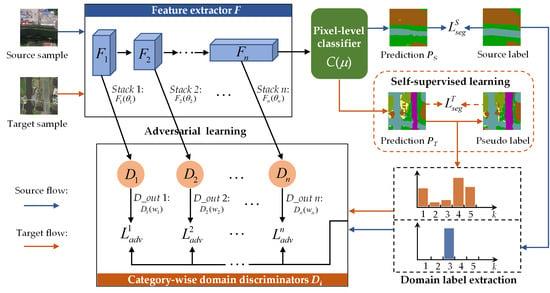Unsupervised Domain Adaption for High-Resolution Coastal Land Cover Mapping with Category-Space Constrained Adversarial Network
Abstract
1. Introduction
- Referring to the characteristics of HRRS images in coastal areas, we propose a category-level UDA approach to achieve land cover mapping across image domains, which emphasizes the advance of adversarial learning in generating and aligning the feature spaces.
- For the category-level adaptation framework, we focus on the underlying category space of the target domain and introduce a category-wise discriminator to fine-tune the segmentation network. In light of heterogeneous situations, two different strategies are adopted to extract domain labels for the discriminator.
- With the lower-level features concerning local details and higher-level ones encoding global context presentations, we integrate the adaptation modules with a similar architecture to each feature stack, aiming to align the semantic features at multiple spatial scales.
- Experiments in two coastal datasets demonstrate that the proposed method enables the cross-domain CLCM to be realized and achieves excellent performance compared with other state-of-the-art models.
2. Background
2.1. Adversarial Learning
2.2. Self-Supervised Learning
3. Materials and Methods
3.1. Problem Setting
3.2. Network Architecture
3.2.1. Overall Formulation
3.2.2. Domain Labels Extraction Module
3.2.3. Single-Level Adaptation Adversarial Framework
3.2.4. Multi-Level Adaptation Adversarial Framework
3.3. Implementation
3.3.1. Subdivided Modules
3.3.2. Training Details
| Algorithm 1. Training process for the hybrid framework. |
| Input: Source images XS, source annotations YS, target images XT, threshold T. Initialized feature extractor F, pixel-level classifier C, and discriminators Di. Output: Well-trained F, C, and Di for adversarial learning. Well-trained F and C for self-supervised learning. |
| fork = 1 to max iterations (M) do if k ≤ 4/5 M (adversarial learning) forward XS, YS to F and C update F, C with forward XT to F, C update predictions PT (score > T) = T forward XT, YS, PT to F, C, Di update F, C, Di with get pseudo label Yt else k > 4/5 M (self-supervised learning) forward XT, Yt to F and C update F, C with end if end for |
4. Experimental Results
4.1. Datasets Description
4.2. Experimental Setting
4.3. Evaluation Metrics
4.4. Results and Analysis
5. Discussion
5.1. Ablation Studies for Network Architecture
5.1.1. Design of Domain Adaptation Framework
5.1.2. Design of Domain Labels Extraction Module
5.2. Effectiveness Analysis of Improvement Strategy
6. Conclusions
Author Contributions
Funding
Institutional Review Board Statement
Informed Consent Statement
Data Availability Statement
Acknowledgments
Conflicts of Interest
References
- Congalton, R.; Gu, J.; Yadav, K.; Thenkabail, P.; Ozdogan, M. Global Land Cover Mapping: A Review and Uncertainty Analysis. Remote Sens. 2014, 6, 12070–12093. [Google Scholar] [CrossRef]
- Scott, G.J.; England, M.R.; Starms, W.A.; Marcum, R.A.; Davis, C.H. Training Deep Convolutional Neural Networks for Land–Cover Classification of High-Resolution Imagery. IEEE Geosci. Remote Sens. 2017, 14, 549–553. [Google Scholar] [CrossRef]
- Chen, J.; Chen, G.; Wang, L.; Fang, B.; Zhou, P.; Zhu, M. Coastal Land Cover Classification of High-Resolution Remote Sensing Images Using Attention-Driven Context Encoding Network. Sensors 2020, 20, 7032. [Google Scholar] [CrossRef]
- Li, X.; Liu, B.; Zheng, G.; Ren, Y.; Zhang, S.; Liu, Y.; Gao, L.; Liu, Y.; Zhang, B.; Wang, F. Deep-learning-based information mining from ocean remote-sensing imagery. Nat. Sci. Rev. 2020, 7, 1584–1605. [Google Scholar] [CrossRef]
- Tsai, Y.; Sohn, K.; Schulter, S.; Chandraker, M. Domain adaptation for structured output via discriminative patch representations. In Proceedings of the IEEE International Conference on Computer Vision (ICCV), Seoul, Korea, 27 October–2 November 2019; pp. 1456–1465. [Google Scholar]
- Long, J.; Shelhamer, E.; Darrell, T. Fully convolutional networks for semantic segmentation. In Proceedings of the IEEE Conference on Computer Vision and Pattern Recognition (CVPR), Boston, MA, USA, 7–12 June 2015; pp. 3431–3440. [Google Scholar]
- Ronneberger, O.; Fischer, P.; Brox, T. U-Net: Convolutional Networks for Biomedical Image Segmentation. In Proceedings of the International Conference on Medical Image Computing and Computer-Assisted Intervention, Munich, Germany, 5–9 October 2015; Springer: Cham, Switzerland, 2015; pp. 234–241. [Google Scholar]
- Zhao, H.; Shi, J.; Qi, X.; Wang, X.; Jia, J. Pyramid scene parsing network. In Proceedings of the IEEE Conference on Computer Vision and Pattern Recognition, Honolulu, HI, USA, 21–26 July 2017; pp. 2881–2890. [Google Scholar]
- Chen, L.; Papandreou, G.; Kokkinos, I.; Murphy, K.; Yuille, A.L. Deeplab: Semantic image segmentation with deep convolutional nets, atrous convolution, and fully connected CRFs. IEEE Trans. Pattern Anal. 2017, 40, 834–848. [Google Scholar] [CrossRef]
- Chen, L.; Papandreou, G.; Schroff, F.; Adam, H. Rethinking atrous convolution for semantic image segmentation. arXiv 2017, arXiv:1706.05587. [Google Scholar]
- Chen, L.; Zhu, Y.; Papandreou, G.; Schroff, F.; Adam, H. Encoder-decoder with atrous separable convolution for semantic image segmentation. In Proceedings of the European Conference on Computer Vision (ECCV), Cham, Switzerland, 8–14 September 2018; pp. 801–818. [Google Scholar]
- Li, Y.; Yuan, L.; Vasconcelos, N. Bidirectional learning for domain adaptation of semantic segmentation. In Proceedings of the IEEE/CVF Conference on Computer Vision and Pattern Recognition, Long Beach, CA, USA, 16–20 June 2019; pp. 6936–6945. [Google Scholar]
- Gong, B.; Shi, Y.; Sha, F.; Grauman, K. Geodesic flow kernel for unsupervised domain adaptation. In Proceedings of the 2012 IEEE Conference on Computer Vision and Pattern Recognition, Providence, RI, USA, 16–21 June 2012; pp. 2066–2073. [Google Scholar]
- Fernando, B.; Habrard, A.; Sebban, M.; Tuytelaars, T. Unsupervised visual domain adaptation using subspace alignment. In Proceedings of the IEEE International Conference on Computer Vision (ICCV), Darling Harbour, Sydney, Australia, 3–6 December 2013; pp. 2960–2967. [Google Scholar]
- Tzeng, E.; Hoffman, J.; Zhang, N.; Saenko, K.; Darrell, T. Deep domain confusion: Maximizing for domain invariance. arXiv 2014, arXiv:1412.3474. [Google Scholar]
- Long, M.; Zhu, H.; Wang, J.; Jordan, M.I. Unsupervised domain adaptation with residual transfer networks. In Proceedings of the Conference and Workshop on Neural Information Processing Systems (NIPS), Barcelona, Spain, 9–10 December 2016; pp. 136–144. [Google Scholar]
- Tzeng, E.; Hoffman, J.; Saenko, K.; Darrell, T. Adversarial discriminative domain adaptation. In Proceedings of the IEEE Conference on Computer Vision and Pattern Recognition, Honolulu, HI, USA, 21–26 July 2017; pp. 7167–7176. [Google Scholar]
- Ganin, Y.; Ustinova, E.; Ajakan, H.; Germain, P.; Larochelle, H.; Laviolette, F.; Marchand, M.; Lempitsky, V. Domain-adversarial training of neural networks. J. Machine Learn. Res. 2016, 17, 2030–2096. [Google Scholar]
- Goodfellow, I.J.; Pouget-Abadie, J.; Mirza, M.; Xu, B.; Warde-Farley, D.; Ozair, S.; Courville, A.; Bengio, Y. Generative adversarial networks. arXiv 2014, arXiv:1406.2661. [Google Scholar]
- Hoffman, J.; Wang, D.; Yu, F.; Darrell, T. FCNs in the wild: Pixel-level adversarial and constraint-based adaptation. arXiv 2016, arXiv:1612.02649. [Google Scholar]
- Tsai, Y.; Hung, W.; Schulter, S.; Sohn, K.; Yang, M.; Chandraker, M. Learning to adapt structured output space for semantic segmentation. In Proceedings of the IEEE/CVF International Conference on Computer Vision, Salt Lake City, UT, USA, 18–23 June 2018; pp. 7472–7481. [Google Scholar]
- Luo, Y.; Liu, P.; Guan, T.; Yu, J.; Yang, Y. Significance-aware information bottleneck for domain adaptive semantic segmentation. In Proceedings of the IEEE/CVF International Conference on Computer Vision, Seoul, Korea, 27 October–2 November 2019; pp. 6778–6787. [Google Scholar]
- Sankaranarayanan, S.; Balaji, Y.; Jain, A.; Lim, S.N.; Chellappa, R. Unsupervised domain adaptation for semantic segmentation with gans. arXiv 2017, arXiv:1711.06969. [Google Scholar]
- Liu, W.; Su, F. Unsupervised adversarial domain adaptation network for semantic segmentation. IEEE Geosci. Remote Sens. 2019, 17, 1978–1982. [Google Scholar] [CrossRef]
- Hoffman, J.; Tzeng, E.; Park, T.; Zhu, J.; Isola, P.; Saenko, K.; Efros, A.; Darrell, T. Cycada: Cycle-consistent adversarial domain adaptation. arXiv 2017, arXiv:1711.03213. [Google Scholar]
- Bousmalis, K.; Silberman, N.; Dohan, D.; Erhan, D.; Krishnan, D. Unsupervised pixel-level domain adaptation with generative adversarial networks. In Proceedings of the IEEE Conference on Computer Vision and Pattern Recognition, Honolulu, HI, USA, 21–26 July 2017; pp. 3722–3731. [Google Scholar]
- Chen, Y.; Lin, Y.; Yang, M.; Huang, J. Crdoco: Pixel-level domain transfer with cross-domain consistency. In Proceedings of the IEEE/CVF Conference on Computer Vision and Pattern Recognition, Long Beach, CA, USA, 16–20 June 2019; pp. 1791–1800. [Google Scholar]
- Zhu, J.; Park, T.; Isola, P.; Efros, A.A. Unpaired image-to-image translation using cycle-consistent adversarial networks. In Proceedings of the IEEE Conference on Computer Vision and Pattern Recognition (CVPR), Honolulu, HI, USA, 21–26 July 2017; pp. 2223–2232. [Google Scholar]
- Liu, M.; Tuzel, O. Coupled generative adversarial networks. arXiv 2016, arXiv:1606.07536. [Google Scholar]
- Luo, Y.; Zheng, L.; Guan, T.; Yu, J.; Yang, Y. Taking a closer look at domain shift: Category-level adversaries for semantics consistent domain adaptation. In Proceedings of the IEEE/CVF Conference on Computer Vision and Pattern Recognition (CVPR), Long Beach, CA, USA, 16–20 June 2019; pp. 2507–2516. [Google Scholar]
- Zou, Y.; Yu, Z.; Kumar, B.; Wang, J. Unsupervised domain adaptation for semantic segmentation via class-balanced self-training. In Proceedings of the European Conference on Computer Vision, Cham, Switzerland, 8–14 September 2018; pp. 289–305. [Google Scholar]
- Zou, Y.; Yu, Z.; Liu, X.; Kumar, B.; Wang, J. Confidence regularized self-training. In Proceedings of the IEEE/CVF International Conference on Computer Vision, Seoul, Korea, 27 October–2 November 2019; pp. 5982–5991. [Google Scholar]
- Vu, T.; Jain, H.; Bucher, M.; Cord, M.; Pérez, P. Advent: Adversarial entropy minimization for domain adaptation in semantic segmentation. In Proceedings of the IEEE/CVF Conference on Computer Vision and Pattern Recognition, Long Beach, CA, USA, 16–20 June 2019; pp. 2517–2526. [Google Scholar]
- Pan, F.; Shin, I.; Rameau, F.; Lee, S.; Kweon, I.S. Unsupervised intra-domain adaptation for semantic segmentation through self-supervision. In Proceedings of the IEEE/CVF Conference on Computer Vision and Pattern Recognition, Seattle, WA, USA, 14–19 June 2020; pp. 3764–3773. [Google Scholar]
- Wang, H.; Shen, T.; Zhang, W.; Duan, L.; Mei, T. Classes Matter: A Fine-grained Adversarial Approach to Cross-domain Semantic Segmentation. In Proceedings of the European Conference on Computer Vision, Edinburgh, UK, 23–28 August 2020; pp. 642–659. [Google Scholar]
- Radford, A.; Metz, L.; Chintala, S. Unsupervised representation learning with deep convolutional generative adversarial networks. arXiv 2015, arXiv:1511.06434. [Google Scholar]
- Mirza, M.; Osindero, S. Conditional generative adversarial nets. arXiv 2014, arXiv:1411.1784. [Google Scholar]
- Liu, X.; Zhang, F.; Hou, Z.; Wang, Z.; Mian, L.; Zhang, J.; Tang, J. Self-supervised learning: Generative or contrastive. arXiv 2020, arXiv:2006.08218. [Google Scholar]
- Chiaroni, F.; Rahal, M.; Hueber, N.; Dufaux, F. Self-supervised learning for autonomous vehicles perception: A conciliation between analytical and Learning methods. IEEE Signal Proc. Mag. 2020, 38, 31–41. [Google Scholar] [CrossRef]
- Zhao, Z.; Luo, Z.; Li, J.; Chen, C.; Piao, Y. When Self-Supervised Learning Meets Scene Classification: Remote Sensing Scene Classification Based on a Multitask Learning Framework. Remote Sens. 2020, 12, 3276. [Google Scholar] [CrossRef]
- Chen, Y.; Chen, W.; Chen, Y.; Tsai, B.; Frank Wang, Y.; Sun, M. No more discrimination: Cross city adaptation of road scene segmenters. In Proceedings of the IEEE International Conference on Computer Vision, Venice, Italy, 22–29 October 2017; pp. 1992–2001. [Google Scholar]
- Chen, L.; Yang, Y.; Wang, J.; Xu, W.; Yuille, A.L. Attention to Scale: Scale-aware Semantic Image Segmentation. arXiv 2015, arXiv:1511.03339. [Google Scholar]
- Sinha, A.; Dolz, J. Multi-scale self-guided attention for medical image segmentation. IEEE J. Biomed. Health 2020. [Google Scholar] [CrossRef] [PubMed]
- He, K.; Zhang, X.; Ren, S.; Sun, J. Deep residual learning for image recognition. In Proceedings of the IEEE Conference on Computer Vision and Pattern Recognition, Seattle, WA, USA, 27–30 June 2016; pp. 770–778. [Google Scholar]
- Deng, J.; Dong, W.; Socher, R.; Li, L.; Li, K.; Fei, L.F. Imagenet: A large-scale hierarchical image database. In Proceedings of the IEEE Conference on Computer Vision and Pattern Recognition, Miami, FL, USA, 20–25 June 2009; pp. 248–255. [Google Scholar]
- Glorot, X.; Bengio, Y. Understanding the Difficulty of Training Deep Feedforward Neural Networks. In Proceedings of the Thirteenth International Conference on Artificial Intelligence and Statistics, Sardinia, Italy, 13–15 May 2010; pp. 249–256. [Google Scholar]
- Maas, A.L.; Hannun, A.Y.; Ng, A.Y. Rectifier nonlinearities improve neural network acoustic models. In Proceedings of the ICML Workshop on Deep Learning for Audio, Speech, and Language Processing, Atlanta, GA, USA, 16–21 June 2013; pp. 1–6. [Google Scholar]
- Deng, Z.; Sun, H.; Zhou, S.; Zhao, J.; Lei, L.; Zou, H. Multi-Scale Object Detection in Remote Sensing Imagery with Convolutional Neural Networks. ISPRS J. Photogramm. Remote Sens. 2018, 145, 3–22. [Google Scholar] [CrossRef]
- Zhao, X.; Gao, L.; Chen, Z.; Zhang, B.; Liao, W. CNN-based Large Scale Landsat Image Classification. In Proceedings of the 2018 Asia-Pacific Signal and Information Processing Association Annual Summit and Conference (APSIPA ASC), Honolulu, HI, USA, 12–15 November 2018; pp. 611–617. [Google Scholar]
- Paszke, A.; Gross, S.; Chintala, S.; Chanan, G.; Yang, E.; DeVito, Z.; Lin, Z.; Desmaison, A.; Antiga, L.; Lerer, A. Automatic differentiation in pytorch. In Proceedings of the 2017 Conference and Workshop on Neural Information Processing Systems (NIPS), Long Beach, CA, USA, 4–10 December 2017; pp. 1–4. [Google Scholar]
- Amari, S. Backpropagation and stochastic gradient descent method. Neurocomputing 1993, 5, 185–196. [Google Scholar] [CrossRef]
- Kingma, D.P.; Ba, J. Adam: A method for stochastic optimization. arXiv 2014, arXiv:1412.6980. [Google Scholar]
- Fang, B.; Kou, R.; Pan, L.; Chen, P. Category sensitive domain adaptation for land cover mapping in aerial scenes. Remote Sens. 2019, 11, 2631. [Google Scholar] [CrossRef]
- Xu, Z.; Su, C.; Zhang, X. A semantic segmentation method with category boundary for Land Use and Land Cover (LULC) mapping of Very-High Resolution (VHR) remote sensing image. Int. J. Remote Sens. 2021, 42, 3146–3165. [Google Scholar] [CrossRef]
- Simonyan, K.; Zisserman, A. Very deep convolutional networks for large-scale image recognition. arXiv 2014, arXiv:1409.1556. [Google Scholar]
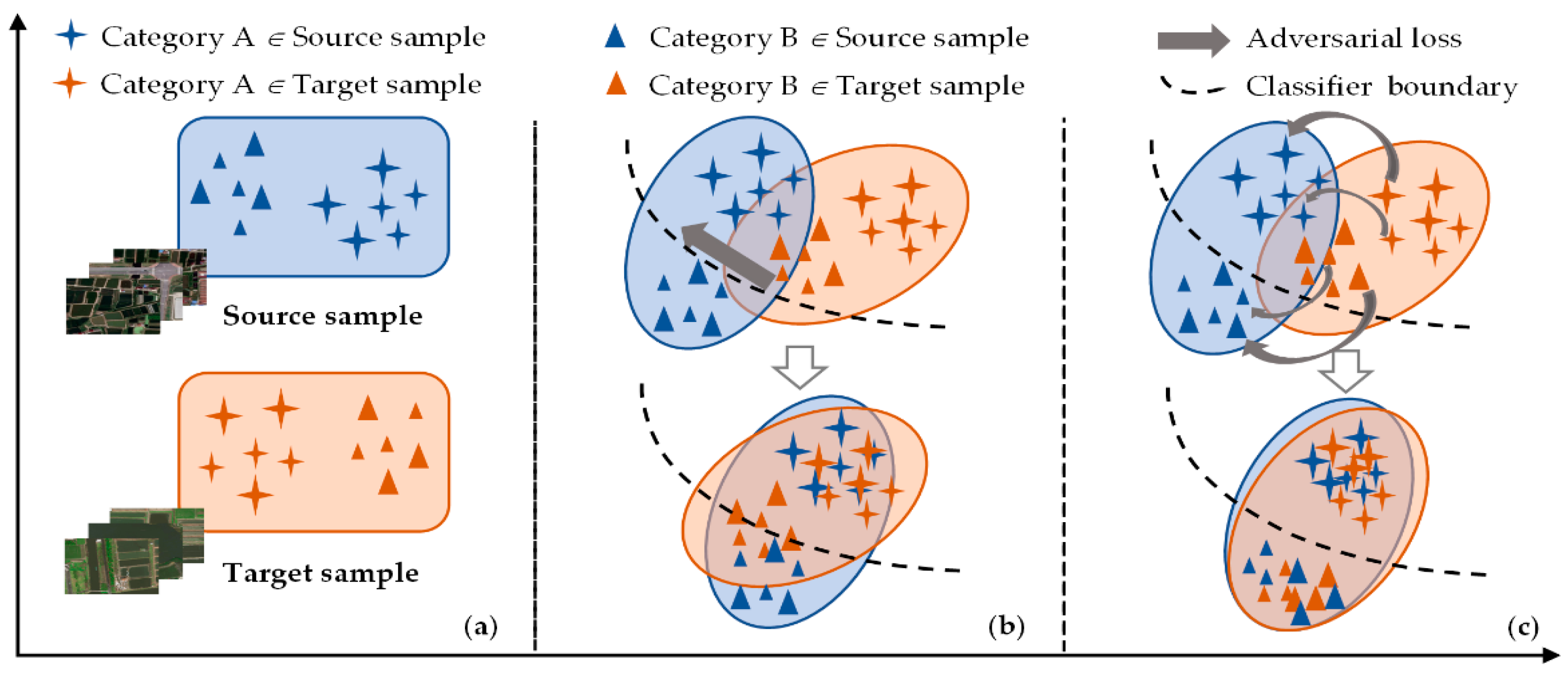
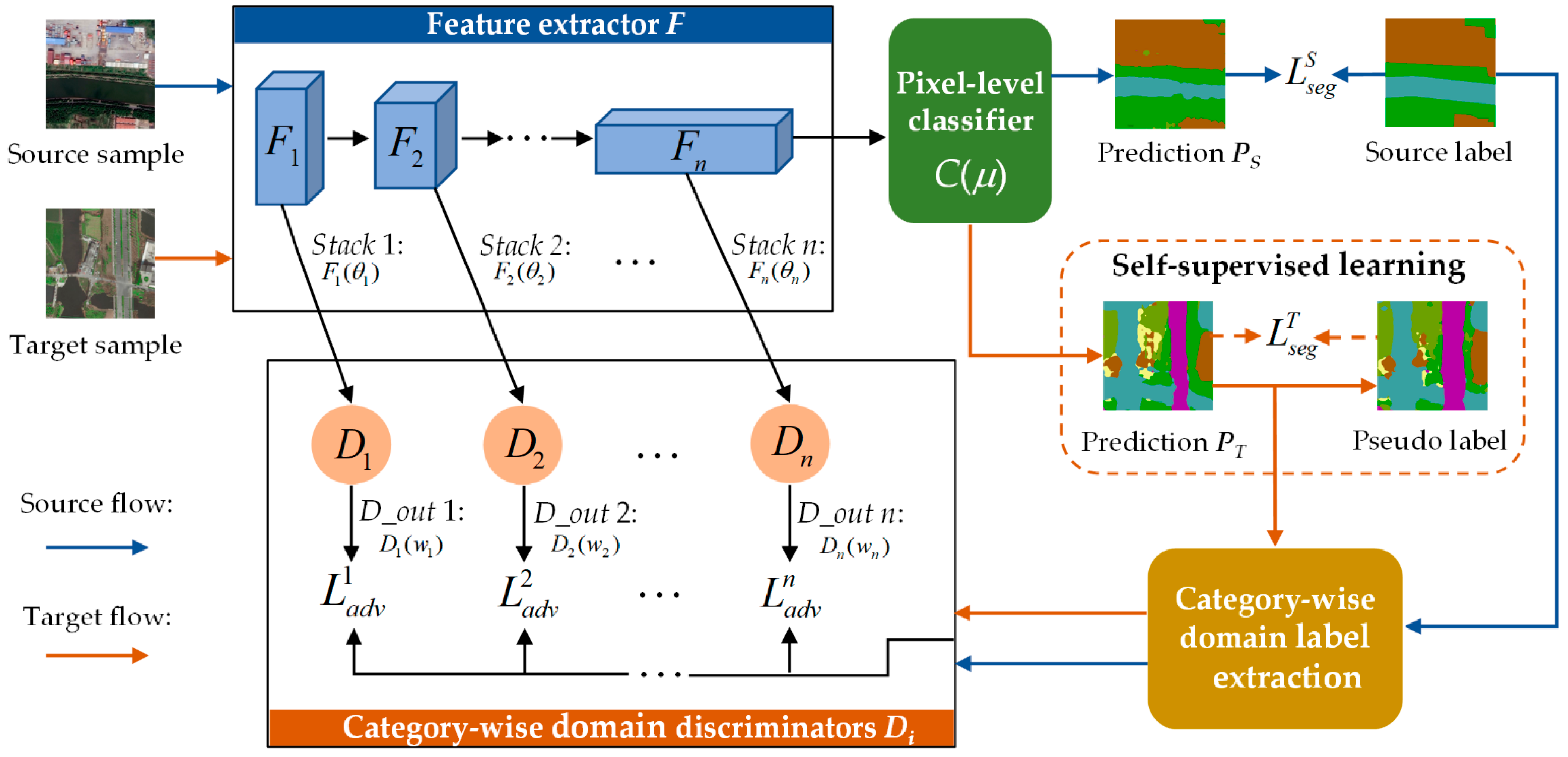
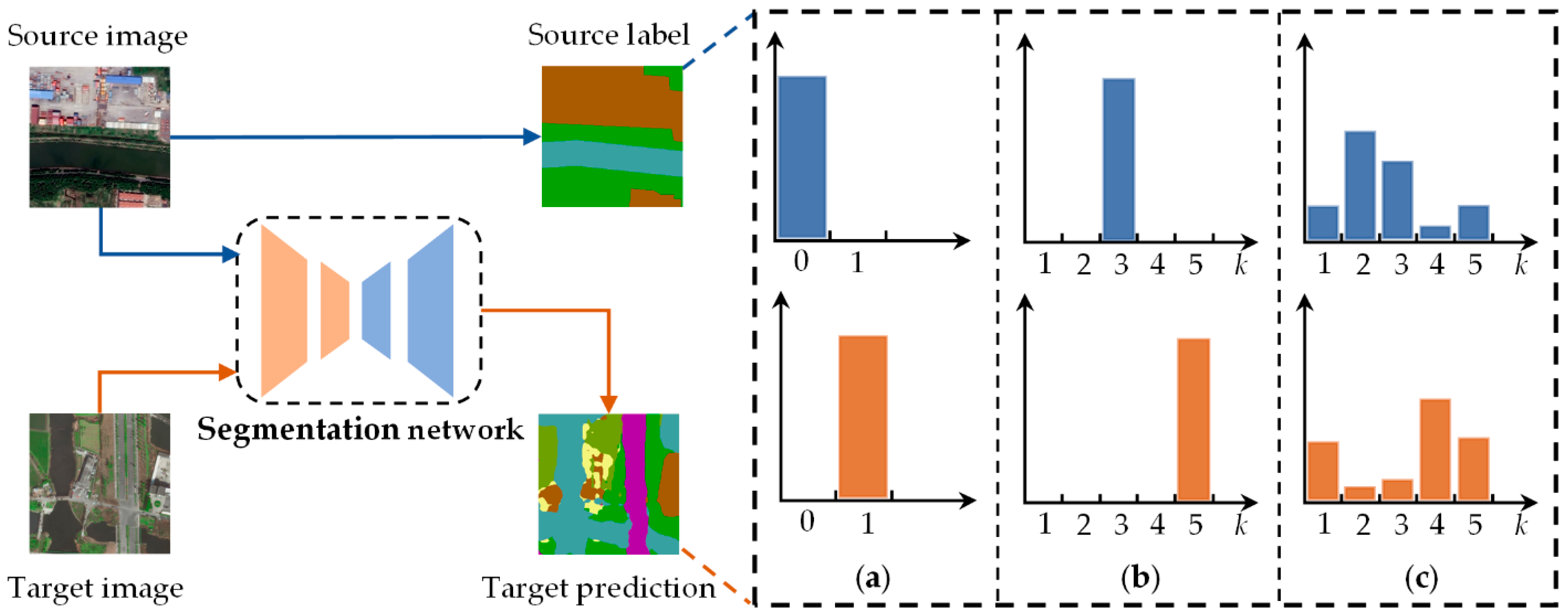
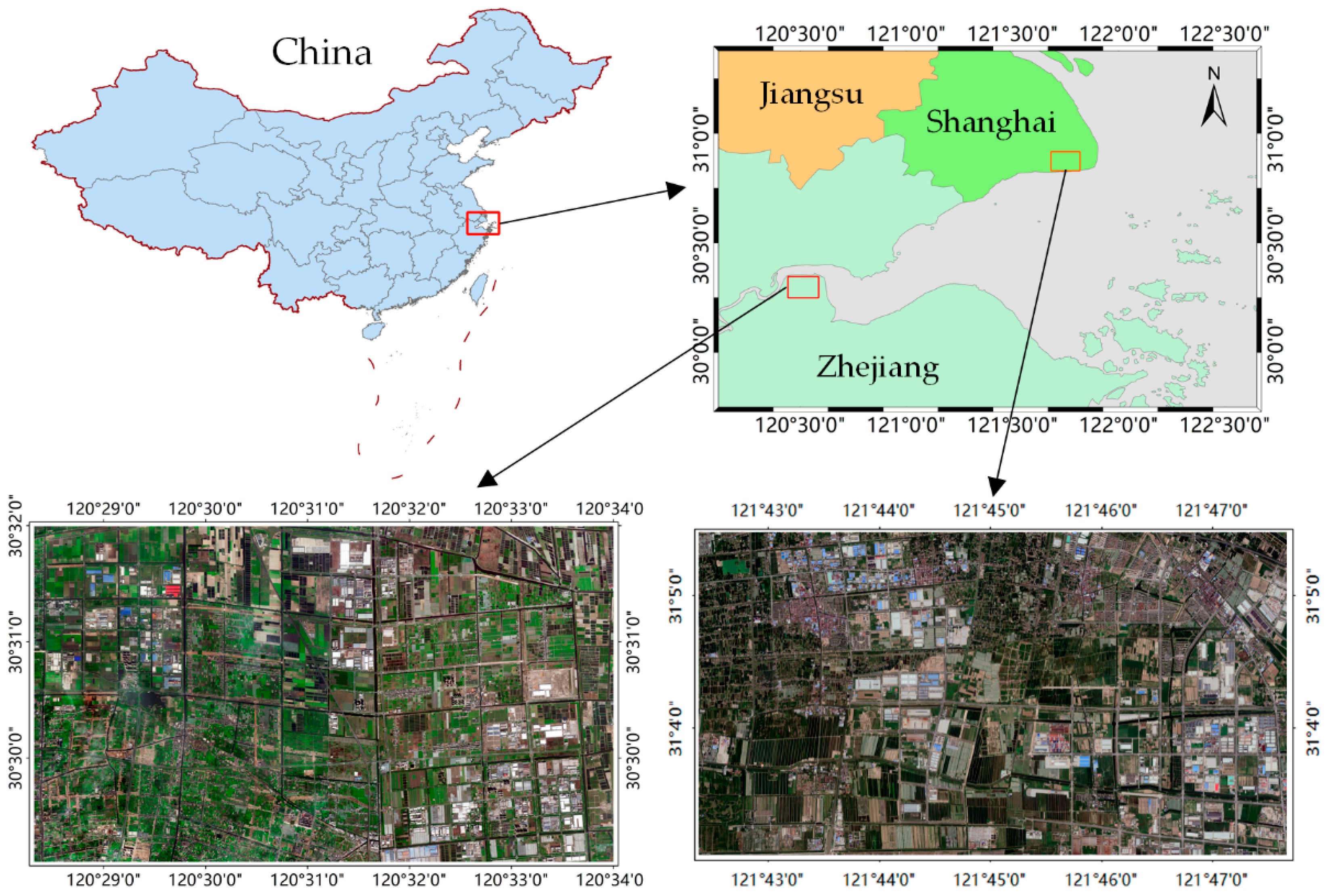
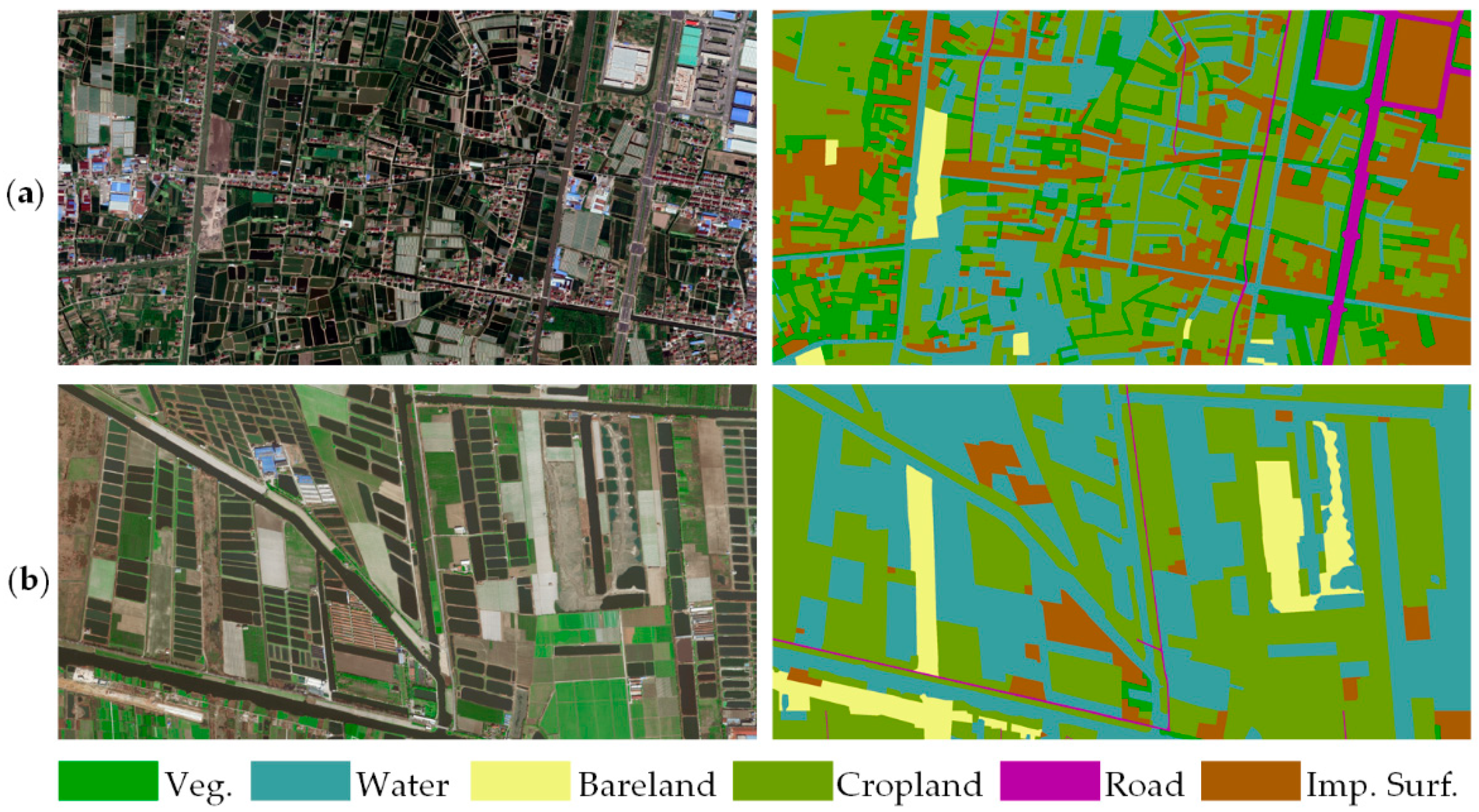
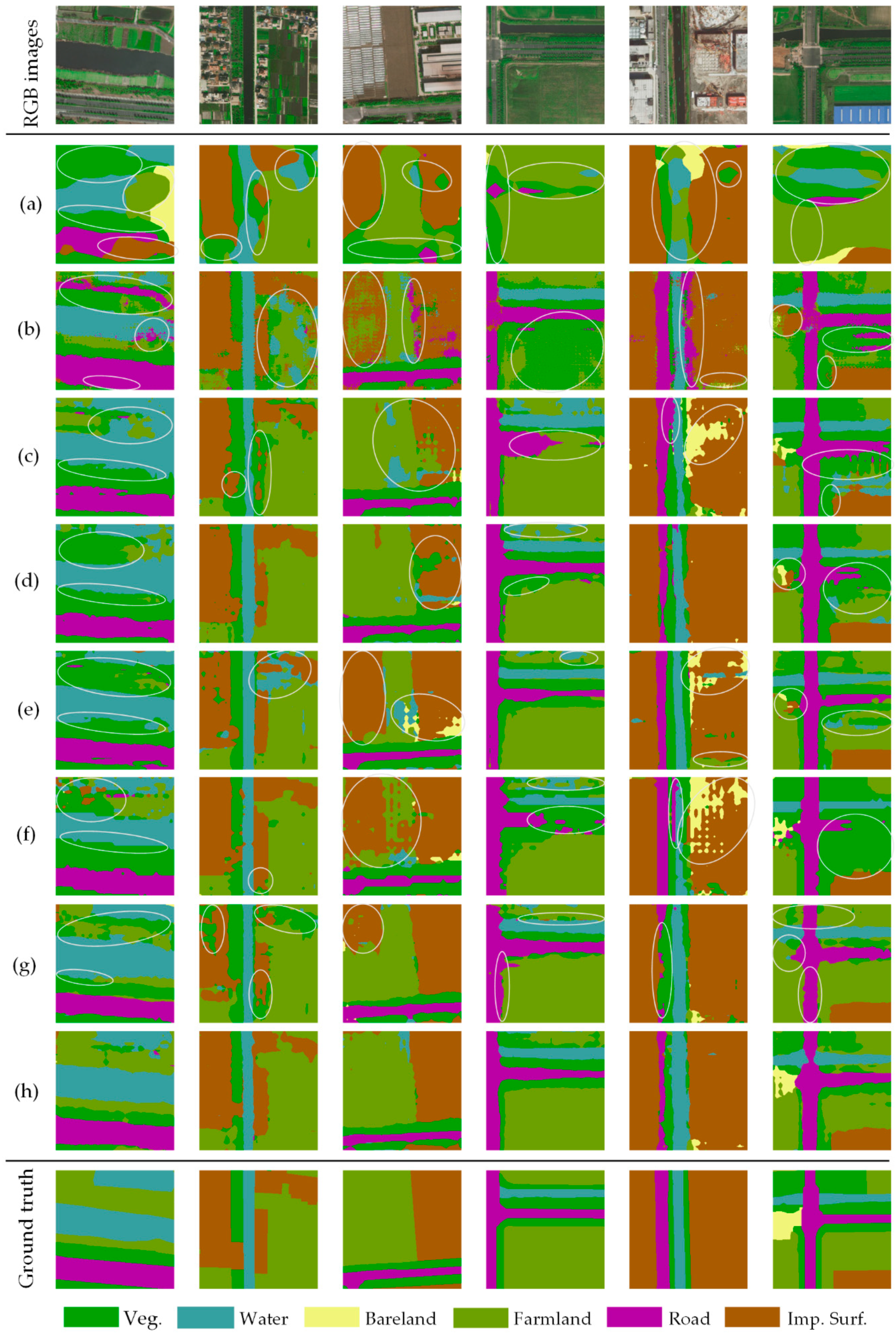
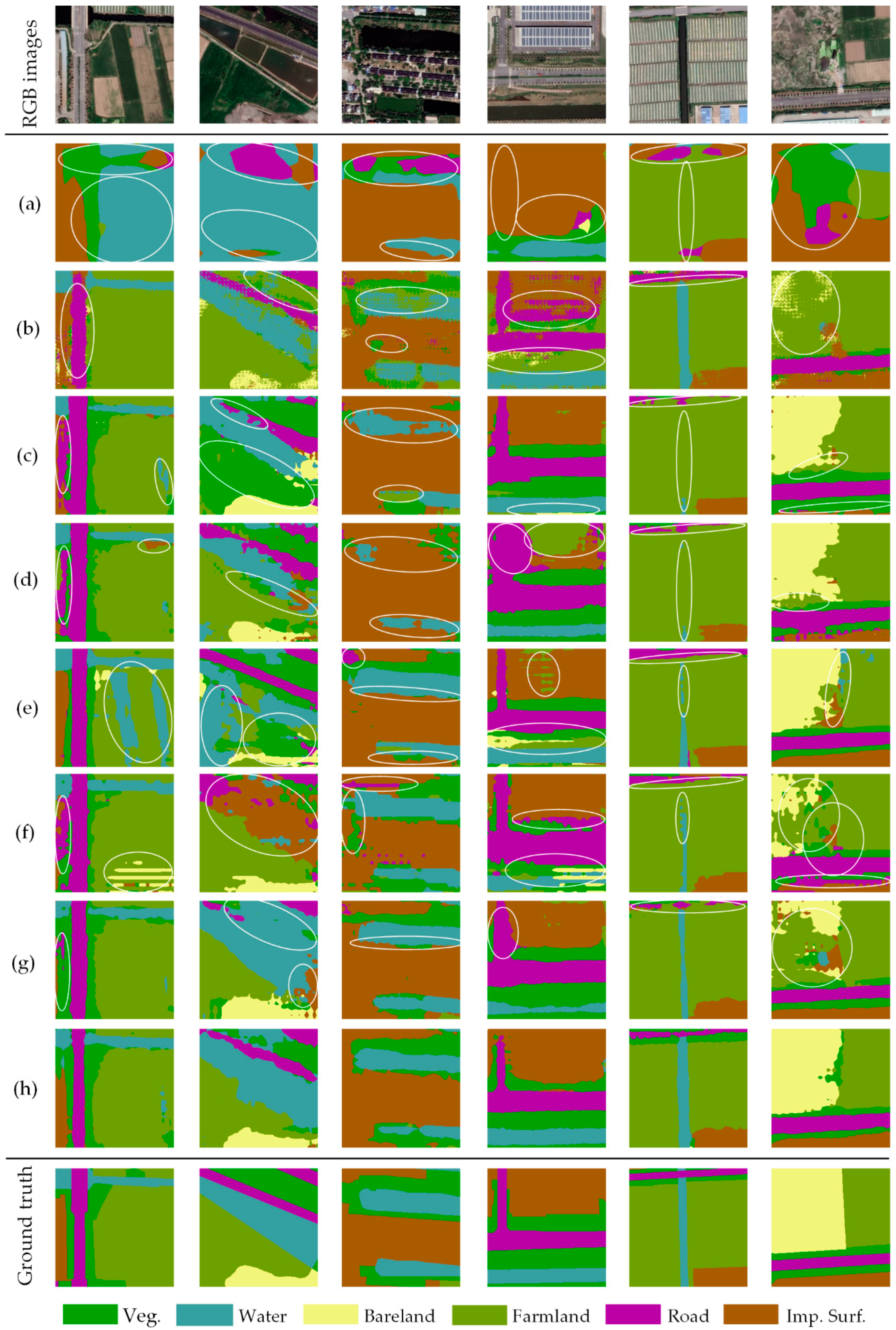
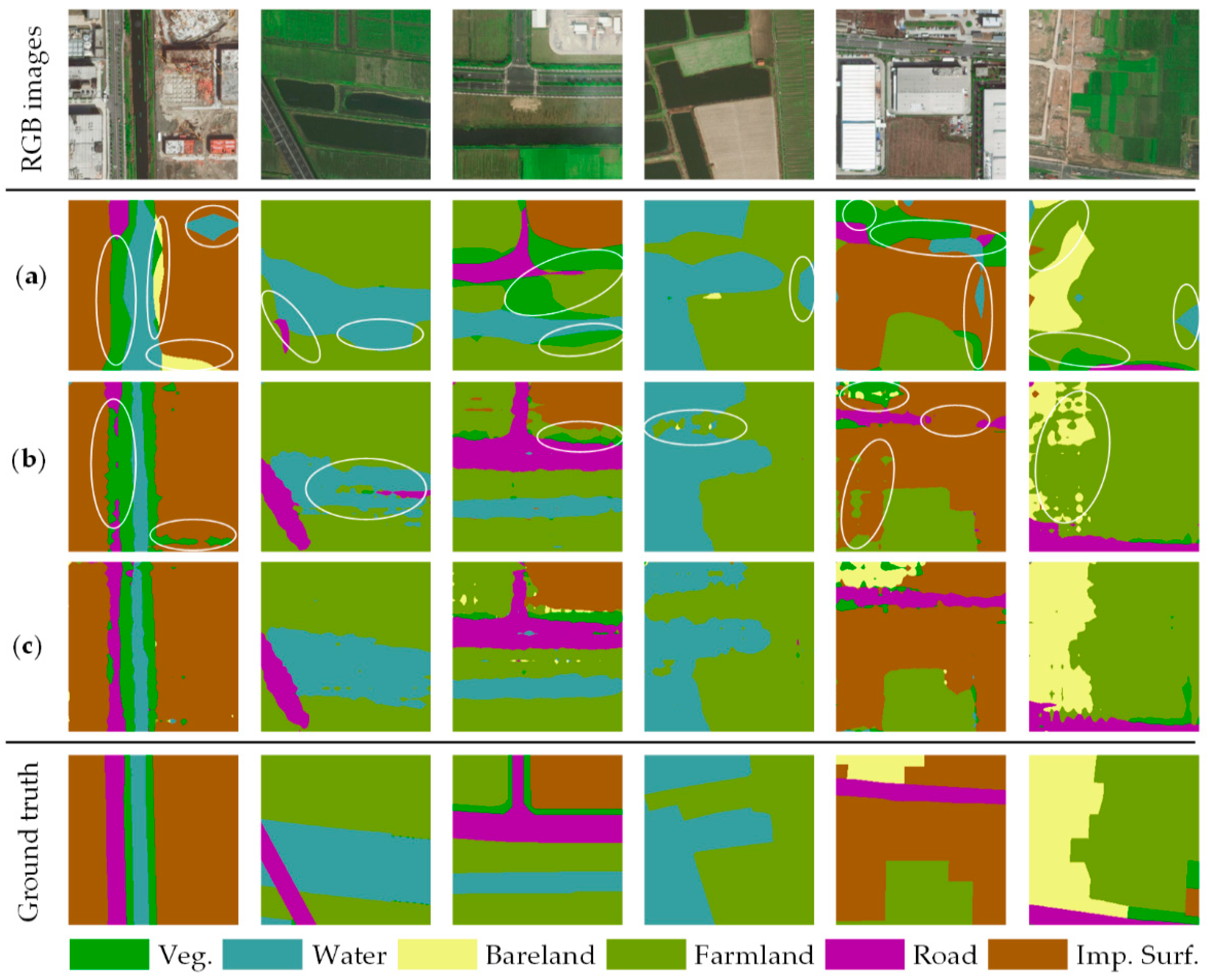
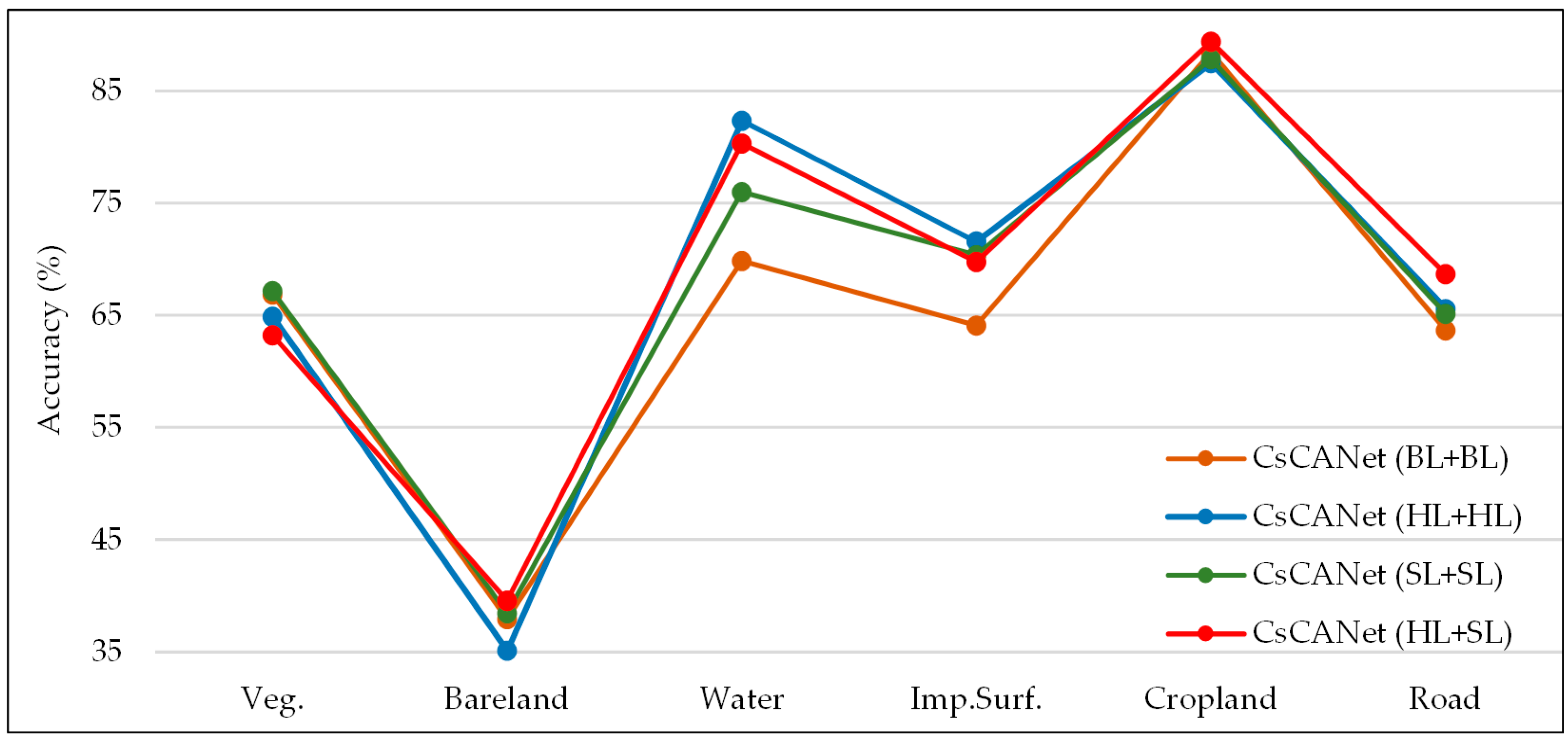
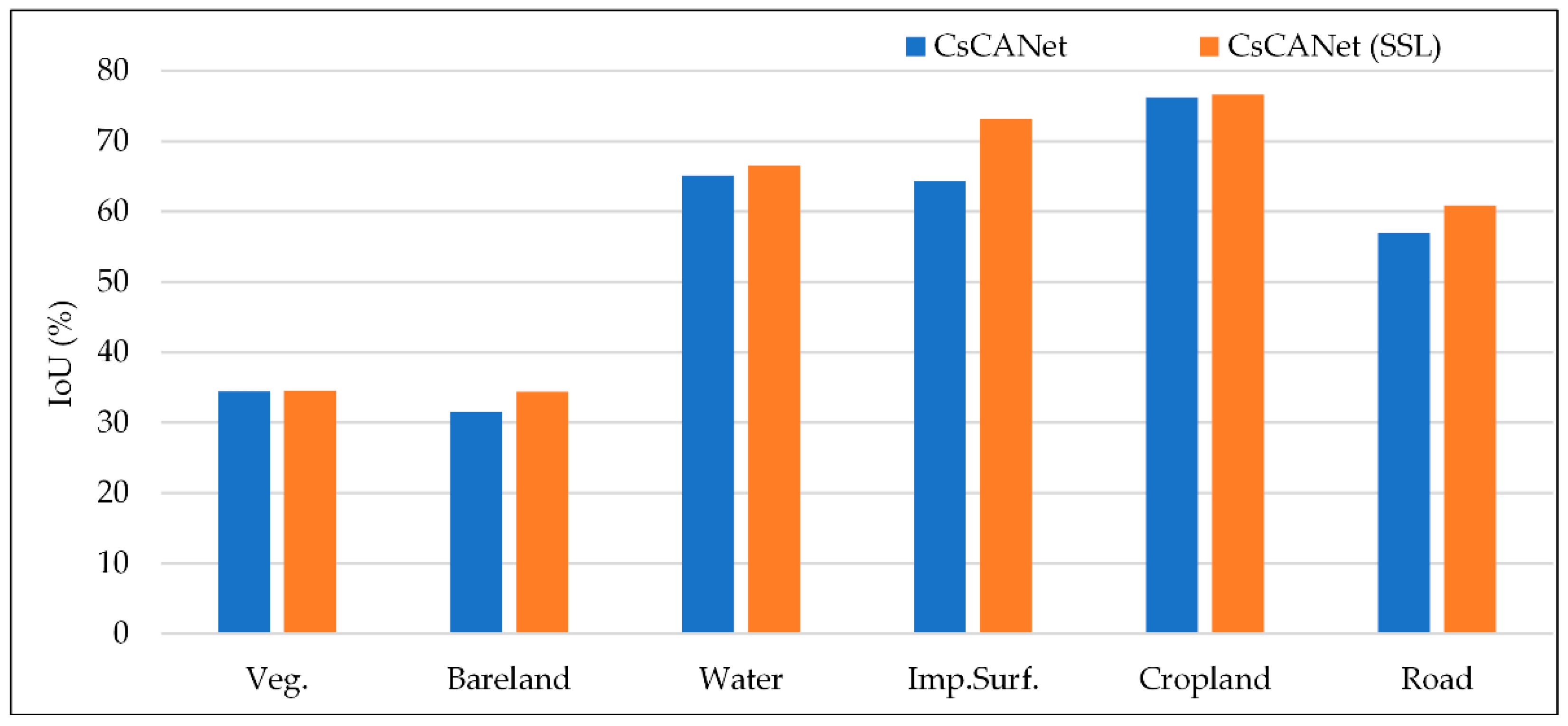
| Category | Shanghai Dataset | Zhejiang Dataset |
|---|---|---|
| Cropland | 32.29% | 46.03% |
| Imp. Surf. | 26.45% | 20.65% |
| Water | 11.44% | 13.46% |
| Veg. | 20.07% | 7.86% |
| Bareland | 3.96% | 7.77% |
| Road | 5.79% | 4.23% |
| Per-class Accuracy | |
| Overall Accuracy | |
| Mean F1 Score | |
| Mean IoU |
| Shanghai → Zhejiang | |||||||||
|---|---|---|---|---|---|---|---|---|---|
| Method | Veg. | Bare Land | Water | Imp.Surf. | Crop Land | Road | OA | mF1 | mIoU |
| FCNs ITW [20] | 40.93 | 12.43 | 40.56 | 59.18 | 79.20 | 10.16 | 58.76 | 40.96 | 28.52 |
| CyCADA [25] | 66.48 | 8.96 | 69.02 | 76.34 | 74.78 | 80.00 | 66.33 | 57.34 | 43.27 |
| AdaptSegNet [21] | 68.14 | 30.07 | 82.97 | 64.19 | 76.17 | 64.83 | 70.21 | 63.57 | 47.99 |
| CLAN [30] | 74.25 | 15.05 | 81.11 | 75.10 | 83.97 | 60.38 | 74.91 | 64.19 | 50.34 |
| ADVENT [33] | 69.77 | 33.05 | 89.13 | 69.43 | 81.55 | 66.45 | 75.03 | 67.90 | 52.94 |
| BDL [12] | 72.17 | 33.56 | 72.04 | 77.98 | 81.98 | 77.10 | 75.19 | 68.00 | 53.29 |
| FADA [35] | 59.88 | 27.32 | 80.98 | 74.62 | 89.89 | 63.98 | 77.42 | 68.15 | 53.93 |
| Our CsCANet | 42.41 | 39.48 | 76.50 | 80.92 | 94.69 | 81.46 | 80.48 | 71.56 | 57.69 |
| Zhejiang → Shanghai | |||||||||
|---|---|---|---|---|---|---|---|---|---|
| Method | Veg. | Bare Land | Water | Imp. Surf. | Crop Land | Road | OA | mF1 | mIoU |
| FCNs ITW [20] | 21.26 | 17.89 | 53.24 | 90.26 | 25.47 | 5.43 | 43.18 | 31.91 | 20.57 |
| CyCADA [25] | 8.09 | 47.92 | 51.19 | 79.58 | 73.74 | 71.76 | 64.31 | 55.43 | 41.69 |
| AdaptSegNet [21] | 42.40 | 67.33 | 64.75 | 90.70 | 55.43 | 65.70 | 63.31 | 60.19 | 43.99 |
| CLAN [30] | 34.58 | 46.25 | 57.93 | 89.66 | 72.83 | 64.67 | 66.37 | 61.22 | 45.09 |
| ADVENT [33] | 46.57 | 44.29 | 59.48 | 89.36 | 57.30 | 77.36 | 64.37 | 61.23 | 45.48 |
| BDL [12] | 39.26 | 50.96 | 46.11 | 83.29 | 76.09 | 74.85 | 66.10 | 60.20 | 44.18 |
| FADA [35] | 36.98 | 30.25 | 71.88 | 94.81 | 67.55 | 66.03 | 67.44 | 61.61 | 46.13 |
| Our CsCANet | 48.35 | 38.75 | 60.62 | 86.53 | 78.26 | 74.63 | 70.55 | 65.33 | 49.64 |
| Method | Domain Adaptation | OA (%) | mF1 (%) | mIoU (%) |
|---|---|---|---|---|
| Baseline | No | 68.61 | 55.86 | 40.81 |
| CsCANet | Single-level | 76.76 | 67.44 | 52.57 |
| CsCANet | Multi-level | 77.52 | 69.25 | 54.78 |
| Method | Binary Label | Category-Wise Hard Label | Category-Wise Soft Label | OA (%) | mF1 (%) | mIoU (%) |
|---|---|---|---|---|---|---|
| CsCANet | S, T | 74.43 | 66.00 | 50.75 | ||
| CsCANet | S, T | 76.93 | 68.17 | 53.58 | ||
| CsCANet | S, T | 76.40 | 68.26 | 53.40 | ||
| CsCANet | S | T | 77.52 | 69.25 | 54.78 |
| Method | Self-Supervised Learning | OA (%) | mF1 (%) | mIoU (%) |
|---|---|---|---|---|
| CsCANet | 77.52 | 69.25 | 54.78 | |
| CsCANet | √ | 80.48 | 71.56 | 57.69 |
Publisher’s Note: MDPI stays neutral with regard to jurisdictional claims in published maps and institutional affiliations. |
© 2021 by the authors. Licensee MDPI, Basel, Switzerland. This article is an open access article distributed under the terms and conditions of the Creative Commons Attribution (CC BY) license (https://creativecommons.org/licenses/by/4.0/).
Share and Cite
Chen, J.; Zhai, G.; Chen, G.; Fang, B.; Zhou, P.; Yu, N. Unsupervised Domain Adaption for High-Resolution Coastal Land Cover Mapping with Category-Space Constrained Adversarial Network. Remote Sens. 2021, 13, 1493. https://doi.org/10.3390/rs13081493
Chen J, Zhai G, Chen G, Fang B, Zhou P, Yu N. Unsupervised Domain Adaption for High-Resolution Coastal Land Cover Mapping with Category-Space Constrained Adversarial Network. Remote Sensing. 2021; 13(8):1493. https://doi.org/10.3390/rs13081493
Chicago/Turabian StyleChen, Jifa, Guojun Zhai, Gang Chen, Bo Fang, Ping Zhou, and Nan Yu. 2021. "Unsupervised Domain Adaption for High-Resolution Coastal Land Cover Mapping with Category-Space Constrained Adversarial Network" Remote Sensing 13, no. 8: 1493. https://doi.org/10.3390/rs13081493
APA StyleChen, J., Zhai, G., Chen, G., Fang, B., Zhou, P., & Yu, N. (2021). Unsupervised Domain Adaption for High-Resolution Coastal Land Cover Mapping with Category-Space Constrained Adversarial Network. Remote Sensing, 13(8), 1493. https://doi.org/10.3390/rs13081493






